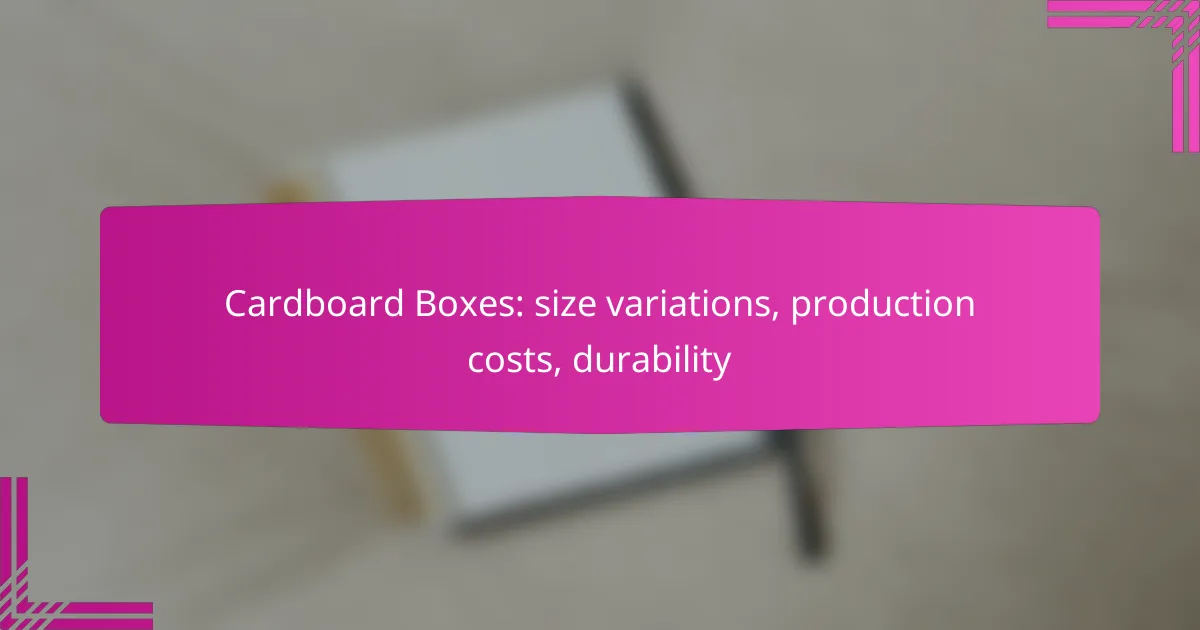Cardboard boxes are essential packaging solutions available in a variety of sizes to meet diverse needs, ranging from standard to custom dimensions. The production costs of these boxes vary based on factors like material choice and manufacturing processes, making it crucial for businesses to understand these elements to manage expenses effectively. Additionally, the durability of cardboard boxes is determined by factors such as material quality and construction, ensuring they can withstand various handling and storage conditions.

What are the size variations of cardboard boxes in New Zealand?
Cardboard boxes in New Zealand come in various sizes to accommodate different packaging needs. These size variations can be categorized into standard sizes, custom sizes, and common dimensions used across industries.
Standard sizes
Standard sizes of cardboard boxes are pre-manufactured dimensions that are widely available and commonly used. Examples include small boxes measuring around 30 x 30 x 30 cm, medium boxes at approximately 40 x 40 x 40 cm, and large boxes around 60 x 60 x 60 cm. These sizes are often used for shipping and storage due to their availability and cost-effectiveness.
Custom sizes
Custom sizes are tailored to specific requirements, allowing businesses to create boxes that fit their products perfectly. This option is ideal for items that do not conform to standard dimensions, minimizing wasted space and material. While custom boxes may incur higher production costs, they can enhance product protection and presentation.
Common dimensions
Common dimensions for cardboard boxes can vary based on the intended use. For instance, boxes for retail packaging often range from 20 x 10 x 10 cm for small items to 50 x 30 x 30 cm for larger products. Understanding the common dimensions helps businesses select the right box for their needs without overpaying for unnecessary space.
Usage scenarios
Different usage scenarios dictate the choice of cardboard box sizes. For e-commerce, smaller boxes are typically used for individual items, while larger boxes may be necessary for bulk shipments. In retail, standard sizes are often preferred for shelf display, ensuring consistency and ease of handling.
Industry standards
Industry standards for cardboard box sizes in New Zealand are influenced by shipping regulations and packaging guidelines. The International Organization for Standardization (ISO) provides specifications that many manufacturers adhere to, ensuring compatibility with shipping containers and pallets. Following these standards can improve logistics efficiency and reduce costs associated with shipping and storage.

How do production costs of cardboard boxes vary?
The production costs of cardboard boxes can differ significantly based on several factors, including material selection, manufacturing processes, and order volume. Understanding these variables can help businesses optimize their packaging expenses.
Material costs
Material costs for cardboard boxes primarily depend on the type of paper used, such as recycled or virgin fibers. Recycled materials generally offer a lower cost but may compromise strength and durability. Prices can fluctuate based on market demand and supply chain conditions, typically ranging from a few cents to several dollars per square meter.
Manufacturing processes
The manufacturing processes for cardboard boxes, such as die-cutting and printing, can influence overall production costs. Automated processes tend to reduce labor costs and increase efficiency, while custom designs may incur additional expenses. It’s essential to balance quality and cost-effectiveness when selecting manufacturing methods.
Volume discounts
Ordering cardboard boxes in larger quantities often leads to significant volume discounts. Suppliers typically offer lower per-unit prices for bulk orders, which can result in savings of 10-30% or more. Businesses should assess their needs and consider consolidating orders to take advantage of these discounts.
Shipping costs
Shipping costs for cardboard boxes can vary based on weight, size, and distance. Larger or heavier boxes may incur higher shipping fees, impacting the total cost of production. It’s advisable to calculate shipping expenses when budgeting for packaging to avoid unexpected costs.
Regional pricing differences
Regional pricing differences can affect the cost of cardboard boxes due to variations in local labor rates, material availability, and transportation costs. For instance, prices may be lower in areas with abundant raw materials or established manufacturing facilities. Businesses should research local suppliers to find the most cost-effective options in their region.

What factors influence the durability of cardboard boxes?
The durability of cardboard boxes is influenced by several key factors, including material quality, box construction, environmental conditions, weight capacity, and testing standards. Understanding these elements can help in selecting the right box for specific needs and ensuring it withstands handling and storage conditions.
Material quality
The quality of the materials used in cardboard production significantly affects durability. High-quality cardboard typically contains stronger fibers and adhesives, which contribute to better resistance against tearing and crushing. Look for boxes made from virgin fibers or high-grade recycled materials for enhanced strength.
Additionally, the thickness of the cardboard, often measured in points or millimeters, plays a crucial role. Thicker cardboard generally provides better durability, making it suitable for heavier items or long-term storage.
Box construction
The construction method of a cardboard box can greatly influence its durability. Boxes with multiple layers, such as double-wall or triple-wall constructions, offer increased strength compared to single-wall boxes. These multi-layer designs are ideal for shipping heavy or fragile items.
Furthermore, the design of the box, including flaps and seams, can impact its structural integrity. Reinforced corners and secure flaps help maintain shape and prevent collapse during handling.
Environmental conditions
Environmental factors such as humidity, temperature, and exposure to sunlight can affect the durability of cardboard boxes. High humidity can weaken cardboard fibers, making them more susceptible to damage. It’s advisable to store cardboard boxes in a dry, temperature-controlled environment to prolong their lifespan.
Moreover, prolonged exposure to sunlight can degrade the material, leading to brittleness. Using boxes with UV-resistant coatings can help mitigate this issue, especially for outdoor storage or shipping.
Weight capacity
The weight capacity of a cardboard box is a critical factor in its durability. Each box is rated for a specific weight limit, and exceeding this limit can lead to failure. Always check the manufacturer’s specifications to ensure the box can handle the intended load.
For heavier items, consider using boxes designed for high weight capacities, which often feature reinforced construction and thicker materials. This will help prevent damage during transport and storage.
Testing standards
Cardboard boxes are often subjected to various testing standards to determine their durability. Common tests include the Edge Crush Test (ECT) and the Burst Test, which measure the box’s strength under pressure and its ability to withstand stacking loads.
When selecting cardboard boxes, look for those that meet industry standards such as ASTM D4727 or ISO 12048. These certifications indicate that the boxes have been tested for durability and can be trusted for reliable performance in shipping and storage applications.

What are the best practices for selecting cardboard boxes?
Selecting the right cardboard boxes involves understanding your specific needs, evaluating different suppliers, and considering factors like size, durability, and cost. Prioritizing these aspects will help ensure you choose the most suitable options for your packaging requirements.
Assessing needs
Begin by clearly defining the purpose of the cardboard boxes. Consider the items you need to package, their dimensions, and weight. For instance, lightweight products may require standard single-wall boxes, while heavier items might need double-wall or triple-wall options for added strength.
Next, think about the storage and shipping conditions. If your boxes will be exposed to moisture, opt for water-resistant materials. Additionally, consider the volume of boxes needed; bulk orders often lead to cost savings, so estimate your requirements accurately.
Comparing suppliers
When comparing suppliers, focus on their reputation, product quality, and pricing. Look for companies that specialize in cardboard packaging and have positive reviews from previous customers. Request samples to assess the durability and quality of their boxes before making a commitment.
Evaluate the pricing structure, including any bulk discounts or shipping costs. It’s also wise to inquire about their production capabilities and lead times, as timely delivery can be crucial for your operations. Finally, ensure that the supplier complies with relevant packaging standards and regulations in your region, which can affect your business’s compliance and reputation.



